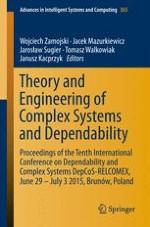Building upon a long tradition of scientifi c conferences dealing with problems of
reliability in technical systems, in 2006 Department of Computer Engineering at
Wrocław University of Technology established DepCoS-RELCOMEX series of events
in order to promote a comprehensive approach to evaluation of system performability
which is now commonly called dependability.
Contemporary complex systems integrate variety of technical, information, soft ware
and human (users, administrators and management) resources. Their complexity
comes not only from involved technical and organizational structures but mainly from
complexity of information processes that must be implemented in specific operational
environment (data processing, monitoring, management, etc.). In such a case traditional
methods of reliability evaluation focused mainly on technical levels are insufficient and
more innovative, multidisciplinary methods of dependability analysis must be applied.
Selection of submissions for these proceedings exemplify diversity of topics that must
be included in such analyses: tools, methodologies and standards for modelling,
design and simulation of the systems, security and confidentiality in information
processing, specific issues of heterogeneous, today often wireless, computer networks,
or management of transportation networks. In addition, this edition of the conference
hosted the 5th CrISS-DESSERT Workshop devoted to the problems of security and
safety in critical information systems.
